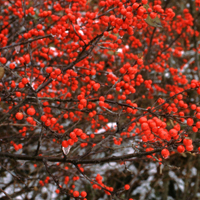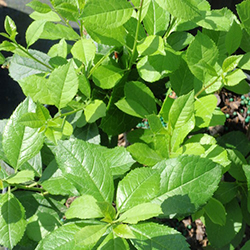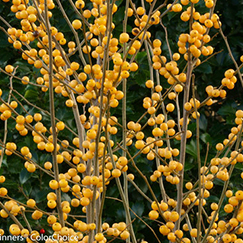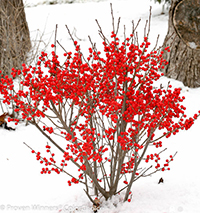Winterberry Brightens Up the Winter Landscape
Learn how this native deciduous holly can add vibrance to your landscape during the otherwise dull winter months.
When most people think of holly, they think of a shrub with bright red berries and glossy evergreen foliage. Holly always has glossy evergreen leaves, right? Well, not always. Ilex verticillata, commonly known as winterberry holly, is a native shrub that loses its leaves each autumn. After the leaves have turned yellow and dropped, you are left with a breathtaking view of thousands of brightly colored berries clinging to every stem. What a joy to have such color in the middle of winter!
 Berry Heavy® Ilex verticillata (deciduous holly) |  Mr. Poppins® Ilex verticillata (deciduous holly) |  Berry Heavy Gold® Ilex verticillata (deciduous holly) |
Winterberry holly is an amazing plant with a tremendous geographical range and a very diverse genetic expression. Native populations of Ilex verticillata stretch from Nova Scotia, south to Florida and west to Missouri. It can be found growing in low grounds, moist woods, swamps and occasionally in higher, drier soils. Though it is most commonly found in moist soils, it can also be grown quite successfully in average garden soils.
This is an easy plant to grow and it has few serious insect or disease problems. As for its genetic variation, this plant can range in heights from 3 feet to 15 feet in the wild. The width of the plant is also variable. In wet sites, it can sucker to form a dense spreading thicket. In drier soil, it tends to form a tighter clump.
Winterberry holly isn't really grown for its flowers, though it does bloom. It has very small, inconspicuous white flowers, with male flowers and female flowers found in different individual plants. In autumn, female plants develop colorful berries where those tiny flowers bloomed. Its slender branches are draped with small but plentiful berries from base to tip. The berries remain on the plant for several weeks to months through winter, as the birds tend not to be interested in them until they have softened considerably. One male winterberry holly will pollinate up to five female plants; to ensure abundant fruit set, plant the male within about 50'/15.25m of the females.
Learn more in this Ultimate Winterberry Guide, which explains how to ensure you get berries.
There are several types of native winterberry cultivars available at garden centers. The Berry Heavy® series of Ilex verticillata was selected for its extra-large, plentiful fruits which can be either red or gold, depending on which cultivar you choose. Mr. Poppins® is the male pollinator for this series. These are full-sized shrubs that stand 6-8 feet tall at maturity.
 |  |  |
All rights reserved © Spring Meadow Nursery, Inc.




